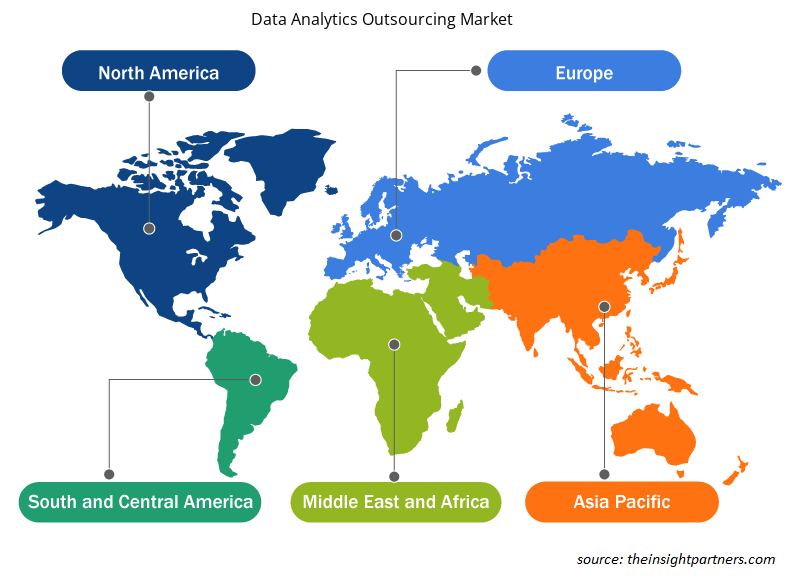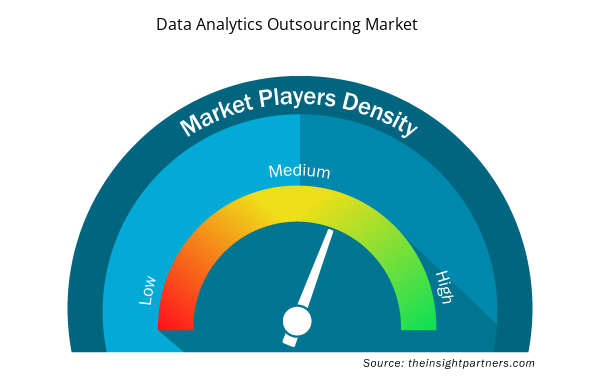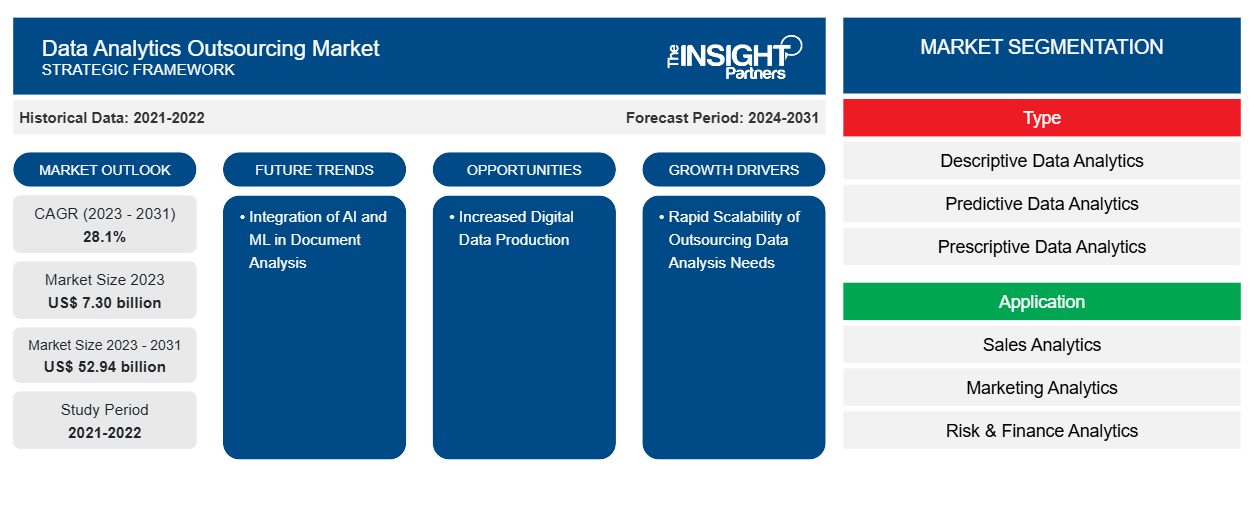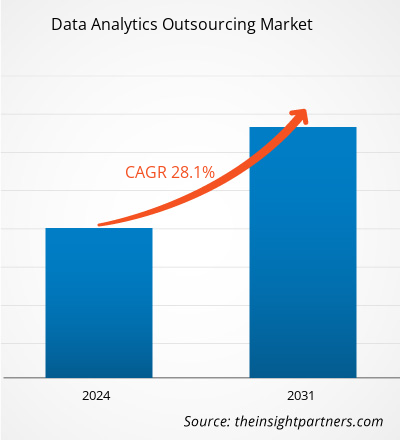データ分析アウトソーシング市場規模は、2023年の73億米ドルから2031年には529億4000万米ドルに達すると予測されています。データ分析アウトソーシング市場は、2023 年から2031年にかけて28.1%のCAGRを記録すると予想されています。データ分析アウトソーシングは、企業が自社のデータをサービスプロバイダーに委託し、インテリジェントな情報を受け取る共同戦略です。
データ分析アウトソーシング市場分析
人工知能 (AI) は、データ分析の多くの要素で人間に取って代わり、手作業の必要性を減らしました。その結果、データ分析のアウトソーシングの性質は、オフショアスタッフの管理ではなく、人間が ML モデルを効率的に設計およびトレーニングする方法に重点が置かれています。大規模なデータ生成により、組織は消費者のセグメンテーション、各カテゴリ内の好みの理解、行動の変化への対応、パーソナライゼーションに関する洞察を求めるようになりました。インターネットの使用が増えたため、企業は現在、膨大な量の整理された非構造化データにアクセスできるようになりました。
データ分析アウトソーシング市場の概要
データ分析のアウトソーシングは、企業が自社のデータをサービス プロバイダーに委託し、インテリジェントな情報を受け取る共同戦略です。同時に、インフラストラクチャのセットアップとサポート、データ管理、分析など、その他のすべての作業をサプライヤーが処理します。経験豊富なサービス プロバイダーにデータ分析をアウトソーシングすると、データ処理の精度が向上し、関連手順が合理化され、情報に基づいた意思決定のための優れた洞察が得られます。さらに、データ分析のアウトソーシング ビジネスでは、常に更新される最先端のツールとテクノロジーを使用して、クライアントに可能な限り最高の結果を提供します。銀行業界では、データ分析は、サイバー セキュリティの向上から顧客離れの最小化まで、さまざまな目的で使用できます。銀行は、取引、規制、ソーシャル メディアのエンゲージメントなどの外部ソースから、処理および分析された追加データを受け取って使用できます。
要件に合わせてレポートをカスタマイズする
このレポートの一部、国レベルの分析、Excelデータパックなど、あらゆるレポートを無料でカスタマイズできます。また、スタートアップや大学向けのお得なオファーや割引もご利用いただけます。
- このレポートの主要な市場動向を入手してください。この無料サンプルには、市場動向から見積もりや予測に至るまでのデータ分析が含まれます。
データ分析アウトソーシング市場の推進要因と機会
デジタルデータ生産の増加が市場を有利にする
デジタル化の時代は、世界的にデジタルデータの生成量の増加をもたらしました。スマートフォンやコンピューターなどのデジタル機器の普及により、デジタルデータへの支出が急増しました。モノのインターネット ( IoT ) の人気の高まりと、その機器によって収集されるデータが、この急増に貢献しています。データアナリストは、膨大な量のデジタルデータを処理して解釈するのに苦労しています。社内ソリューションに関連するコストの高さと初期投資のため、企業はデータ分析ソリューションをアウトソーシングする傾向が高まっています。アウトソーシングサービスは、組織が分析フレームワークを迅速に確立するのに役立ちます。これは、そうでなければ困難であったり、時間がかかる可能性があります。
アウトソーシングデータ分析ニーズの迅速な拡張
アウトソーシング サービスは、組織が分析フレームワークを迅速に開発するのにも役立ちます。これは、中小企業の社内能力では実行が困難、あるいは不可能で、費用もかかります。さらに、アウトソーシング ベンダーのテクノロジとリソースを活用して、高度なデータ センター、ロボット プロセス オートメーション、クラウド ベースのソフトウェアの実装など、データ分析ツールとプロセスの運用効率を向上させることは、大きな利点となります。AMR によると、データ分析をサードパーティ パートナーにアウトソーシングすると、企業はこれまで検討していなかったより創造的なソリューションを使用することもできます。中小企業は、そのような専門知識を社内で採用できない場合があります。
データ分析アウトソーシング市場レポートのセグメンテーション分析
データ分析アウトソーシング市場分析の導出に貢献した主要なセグメントは、タイプ、アプリケーション、エンドユーザーです。
- タイプに基づいて、データ分析アウトソーシング市場は、記述的データ分析、予測的データ分析、および規範的データ分析に分類されます。
- アプリケーション別に見ると、市場は販売分析、マーケティング分析、リスクと財務分析、サプライチェーン分析に分類されます。
- エンドユーザーに基づいて、データ分析アウトソーシング市場は、BFSI、ヘルスケア、小売、製造、通信、メディアおよびエンターテイメントに分類されます。
地域別データ分析アウトソーシング市場シェア分析
データ分析アウトソーシング市場レポートの地理的範囲は、主に北米、アジア太平洋、ヨーロッパ、中東およびアフリカ、南米/中南米の 5 つの地域に分かれています。ソーシャル浸透率の上昇データには、標準的な分析ツールでは検出できないパターンが隠れています。We Are Social によると、昨年の中国と米国のアクティブ ソーシャル ネットワーク浸透率はそれぞれ 64.6% と 72.3% で、分析を必要とする大量のデータ生成を示しています。これにより、全国の企業がデータ分析をアウトソーシングするようになっています。
データ分析アウトソーシング市場の地域別分析
予測期間を通じてデータ分析アウトソーシング市場に影響を与える地域的な傾向と要因は、Insight Partners のアナリストによって徹底的に説明されています。このセクションでは、北米、ヨーロッパ、アジア太平洋、中東およびアフリカ、南米および中米にわたるデータ分析アウトソーシング市場のセグメントと地理についても説明します。

- データ分析アウトソーシング市場の地域別データを入手
データ分析アウトソーシング市場レポートの範囲
| レポート属性 | 詳細 |
|---|---|
| 2023年の市場規模 | 73億ドル |
| 2031年までの市場規模 | 529.4億米ドル |
| 世界のCAGR(2023年~2031年) | 28.1% |
| 履歴データ | 2021-2022 |
| 予測期間 | 2024-2031 |
| 対象セグメント | タイプ別
|
| 対象地域と国 | 北米
|
| 市場リーダーと主要企業プロフィール |
|
データ分析アウトソーシング市場のプレーヤー密度:ビジネスダイナミクスへの影響を理解する
データ分析アウトソーシング市場は、消費者の嗜好の変化、技術の進歩、製品の利点に対する認識の高まりなどの要因により、エンドユーザーの需要が高まり、急速に成長しています。需要が高まるにつれて、企業は提供内容を拡大し、消費者のニーズを満たすために革新を起こし、新たなトレンドを活用し、市場の成長をさらに促進しています。
市場プレーヤー密度とは、特定の市場または業界内で活動している企業または会社の分布を指します。これは、特定の市場スペースに、その市場規模または総市場価値に対してどれだけの競合相手 (市場プレーヤー) が存在するかを示します。
データ分析アウトソーシング市場で事業を展開している主要企業は次のとおりです。
- アクセンチュア
- キャップジェミニ SE
- フラクタルアナリティクス株式会社
- ジェンパクト
- インフォシス・リミテッド
- ミューシグマ株式会社
免責事項:上記の企業は、特定の順序でランク付けされていません。

- データ分析アウトソーシング市場のトップキープレーヤーの概要を入手
データ分析アウトソーシング市場のニュースと最近の動向
データ分析アウトソーシング市場は、重要な企業出版物、協会データ、データベースなど、一次調査と二次調査後の定性的および定量的データを収集することで評価されます。以下は、市場の動向の一覧です。
- 2023 年 6 月、Genpact は、生成型 AI の導入を活用して実用的なビジネス インサイトを推進するなど、企業が人工知能 (AI) 戦略を加速できるよう支援するために、Google Cloud とのコラボレーションを発表しました。
(出典:Genpact、プレスリリース、2023年)
- 2023 年 9 月、IBM は Watsonx に新しい生成 AI ベースのモデルとアップグレードを導入する計画を発表しました。これらの追加には、Watsonx のテクニカル プレビューが含まれます。Watsonx はまもなく、ガバナンスと新しい豊富な AI データ オファリングを提供します。データと、Watsonx.ai 基盤モデルの、選択されたソフトウェアおよびインフラストラクチャ製品への計画的な統合。
(出典:IBM、プレスリリース、2023年)
データ分析アウトソーシング市場レポートの対象範囲と成果物
「データ分析アウトソーシング市場の規模と予測(2021〜2031年)」レポートでは、以下の分野をカバーする市場の詳細な分析を提供しています。
- 対象範囲に含まれるすべての主要市場セグメントの世界、地域、国レベルでの市場規模と予測
- 市場の動向(推進要因、制約、主要な機会など)
- 今後の主な動向
- 詳細なPEST/ポーターの5つの力とSWOT分析
- 主要な市場動向、主要プレーヤー、規制、最近の市場動向を網羅した世界および地域の市場分析
- 市場集中、ヒートマップ分析、主要プレーヤー、最近の動向を網羅した業界の状況と競争分析
- 詳細な企業プロフィール
- 過去2年間の分析、基準年、CAGRによる予測(7年間)
- PEST分析とSWOT分析
- 市場規模価値/数量 - 世界、地域、国
- 業界と競争環境
- Excel データセット



Report Coverage
Revenue forecast, Company Analysis, Industry landscape, Growth factors, and Trends

Segment Covered
This text is related
to segments covered.

Regional Scope
North America, Europe, Asia Pacific, Middle East & Africa, South & Central America

Country Scope
This text is related
to country scope.
よくある質問
The global data analytics outsourcing market was estimated to be US$ 7.30 billion in 2023 and is expected to grow at a CAGR of 28.1% during the forecast period 2023 - 2031.
Increased digital data production is the major factors that propel the global data analytics outsourcing market.
The development of new applications is anticipated to play a significant role in the global data analytics outsourcing market in the coming years.
The key players holding majority shares in the global data analytics outsourcing market are Accenture, Capgemini SE, Fractal Analytics Inc., Genpact, and Infosys Limited.
The global data analytics outsourcing market is expected to reach US$ 52.94 billion by 2031.
Trends and growth analysis reports related to Technology, Media and Telecommunications : READ MORE..
The Insight Partners performs research in 4 major stages: Data Collection & Secondary Research, Primary Research, Data Analysis and Data Triangulation & Final Review.
- Data Collection and Secondary Research:
As a market research and consulting firm operating from a decade, we have published and advised several client across the globe. First step for any study will start with an assessment of currently available data and insights from existing reports. Further, historical and current market information is collected from Investor Presentations, Annual Reports, SEC Filings, etc., and other information related to company’s performance and market positioning are gathered from Paid Databases (Factiva, Hoovers, and Reuters) and various other publications available in public domain.
Several associations trade associates, technical forums, institutes, societies and organization are accessed to gain technical as well as market related insights through their publications such as research papers, blogs and press releases related to the studies are referred to get cues about the market. Further, white papers, journals, magazines, and other news articles published in last 3 years are scrutinized and analyzed to understand the current market trends.
- Primary Research:
The primarily interview analysis comprise of data obtained from industry participants interview and answers to survey questions gathered by in-house primary team.
For primary research, interviews are conducted with industry experts/CEOs/Marketing Managers/VPs/Subject Matter Experts from both demand and supply side to get a 360-degree view of the market. The primary team conducts several interviews based on the complexity of the markets to understand the various market trends and dynamics which makes research more credible and precise.
A typical research interview fulfils the following functions:
- Provides first-hand information on the market size, market trends, growth trends, competitive landscape, and outlook
- Validates and strengthens in-house secondary research findings
- Develops the analysis team’s expertise and market understanding
Primary research involves email interactions and telephone interviews for each market, category, segment, and sub-segment across geographies. The participants who typically take part in such a process include, but are not limited to:
- Industry participants: VPs, business development managers, market intelligence managers and national sales managers
- Outside experts: Valuation experts, research analysts and key opinion leaders specializing in the electronics and semiconductor industry.
Below is the breakup of our primary respondents by company, designation, and region:

Once we receive the confirmation from primary research sources or primary respondents, we finalize the base year market estimation and forecast the data as per the macroeconomic and microeconomic factors assessed during data collection.
- Data Analysis:
Once data is validated through both secondary as well as primary respondents, we finalize the market estimations by hypothesis formulation and factor analysis at regional and country level.
- Macro-Economic Factor Analysis:
We analyse macroeconomic indicators such the gross domestic product (GDP), increase in the demand for goods and services across industries, technological advancement, regional economic growth, governmental policies, the influence of COVID-19, PEST analysis, and other aspects. This analysis aids in setting benchmarks for various nations/regions and approximating market splits. Additionally, the general trend of the aforementioned components aid in determining the market's development possibilities.
- Country Level Data:
Various factors that are especially aligned to the country are taken into account to determine the market size for a certain area and country, including the presence of vendors, such as headquarters and offices, the country's GDP, demand patterns, and industry growth. To comprehend the market dynamics for the nation, a number of growth variables, inhibitors, application areas, and current market trends are researched. The aforementioned elements aid in determining the country's overall market's growth potential.
- Company Profile:
The “Table of Contents” is formulated by listing and analyzing more than 25 - 30 companies operating in the market ecosystem across geographies. However, we profile only 10 companies as a standard practice in our syndicate reports. These 10 companies comprise leading, emerging, and regional players. Nonetheless, our analysis is not restricted to the 10 listed companies, we also analyze other companies present in the market to develop a holistic view and understand the prevailing trends. The “Company Profiles” section in the report covers key facts, business description, products & services, financial information, SWOT analysis, and key developments. The financial information presented is extracted from the annual reports and official documents of the publicly listed companies. Upon collecting the information for the sections of respective companies, we verify them via various primary sources and then compile the data in respective company profiles. The company level information helps us in deriving the base number as well as in forecasting the market size.
- Developing Base Number:
Aggregation of sales statistics (2020-2022) and macro-economic factor, and other secondary and primary research insights are utilized to arrive at base number and related market shares for 2022. The data gaps are identified in this step and relevant market data is analyzed, collected from paid primary interviews or databases. On finalizing the base year market size, forecasts are developed on the basis of macro-economic, industry and market growth factors and company level analysis.
- Data Triangulation and Final Review:
The market findings and base year market size calculations are validated from supply as well as demand side. Demand side validations are based on macro-economic factor analysis and benchmarks for respective regions and countries. In case of supply side validations, revenues of major companies are estimated (in case not available) based on industry benchmark, approximate number of employees, product portfolio, and primary interviews revenues are gathered. Further revenue from target product/service segment is assessed to avoid overshooting of market statistics. In case of heavy deviations between supply and demand side values, all thes steps are repeated to achieve synchronization.
We follow an iterative model, wherein we share our research findings with Subject Matter Experts (SME’s) and Key Opinion Leaders (KOLs) until consensus view of the market is not formulated – this model negates any drastic deviation in the opinions of experts. Only validated and universally acceptable research findings are quoted in our reports.
We have important check points that we use to validate our research findings – which we call – data triangulation, where we validate the information, we generate from secondary sources with primary interviews and then we re-validate with our internal data bases and Subject matter experts. This comprehensive model enables us to deliver high quality, reliable data in shortest possible time.


 このレポートの無料サンプルを入手する
このレポートの無料サンプルを入手する